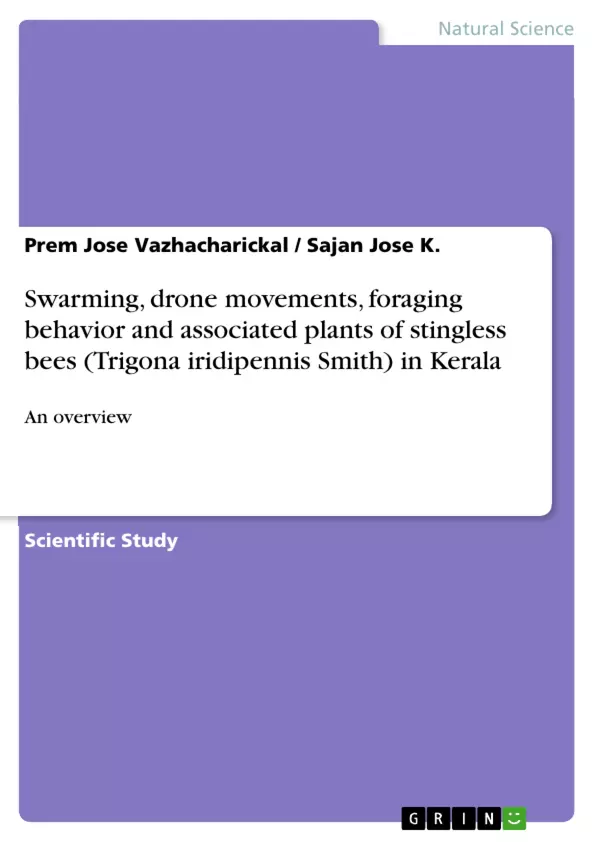Stingless bees are highly social insects which populated the tropical earth 65 million years ago longer than honey bees. They are limited to tropics and subtropics lacking venom apparatus and cannot sting. Impacts of anthropogenic influences on honey bees were already reported. Based on these back ground, the objectives of this study were to 1) to characterize the swarming and drone movements of Trigona iridipennis Smith in Kerala 2) to identify the foraging behaviour, colour preference and various plants associated with Trigona iridipennis Smith for nest construction as well as dietary sources.
Feral as well as hived colonies of stingless bees were located and fixed at different parts of Kerala for observations on their foraging activity. Bee traffic was also measured during various timings across a bright sunny day in November 2013 and between colonies. Bee traffic among Trigona iridipennis Smith varied widely among the selected four colonies during various time intervals. In all the colonies bee traffic starts between 6 to 7 am and end by 7 to 7.10 pm. Bee traffic exhibited two peaks. One during 10 to 10.10 am and the other 2 to 3.10 pm. But in colony 4 the picture is different, where the morning peak was 11 to 11.10 am and the afternoon peak was 3 to 3.10 pm.
Trigona iridipennis Smith shows great diversity in plant selection for dietary as well as resin sources. The shift towards ornamental plants for foraging may be an adaptation evolved in response to human modification of the environment. The bees collect resin from a variety of sources for building nest, its maintenance and also for defence. Bee traffic is found to be related to time, season, and strength of the colony. The bees preferred white and yellow coloured flowers than pink and red. The study also highlights the various food sources of Trigona iridipennis Smith in Kerala which can be further explored for flourishing melliponiculture.
Inhaltsverzeichnis (Table of Contents)
- Abstract
- 1. Introduction
- 2. Materials and Methods
- 2.1 Study area
- 2.2 Study design and data collection
- 2.3 Statistical analysis
- 3. Results and discussion
- 3.1 Pasturage sources
- 3.2 Pollen source
- 3.3 Nectar source
- 3.4 Resin source
- 3.5 Resin collection procedure
- 3.6 Net-log experiment
- 3.7 Nesting trees
- 3.8 Bee traffic
- 3.9 Swarming
- 3.10 Drone movement
- 3.11 Colour preference
- 4. Conclusions
- Acknowledgements
- References
Zielsetzung und Themenschwerpunkte (Objectives and Key Themes)
This research delves into the swarming, drone movements, foraging behavior, and associated plants of stingless bees (Trigona iridipennis Smith) in Kerala, India. The study aims to provide a comprehensive overview of these aspects, shedding light on the ecological role of these bees in the region.
- Foraging behavior and preferred plant species for pollen, nectar, and resin collection
- Swarming patterns and factors influencing colony establishment
- Drone movements and their role in reproduction
- The impact of color preference on foraging behavior
- The ecological significance of stingless bees in the Kerala ecosystem
Zusammenfassung der Kapitel (Chapter Summaries)
- Introduction: This chapter provides background information on stingless bees, their ecological importance, and the specific focus of the study on Trigona iridipennis Smith in Kerala.
- Materials and Methods: This chapter outlines the study area, the research design, data collection techniques, and statistical analysis methods used in the study.
- Results and Discussion: This chapter presents the findings of the study, including information on the pasturage sources, pollen, nectar, and resin sources used by the bees, their foraging behavior, swarming patterns, drone movements, and color preferences. It also discusses the ecological implications of these findings.
Schlüsselwörter (Keywords)
Stingless bees, Trigona iridipennis Smith, Kerala, India, foraging behavior, pollen, nectar, resin, swarming, drone movement, color preference, ecological significance, pollination, biodiversity.
- Citation du texte
- Dr. Prem Jose Vazhacharickal (Auteur), Sajan Jose K. (Auteur), 2014, Swarming, drone movements, foraging behavior and associated plants of stingless bees (Trigona iridipennis Smith) in Kerala, Munich, GRIN Verlag, https://www.grin.com/document/349822



